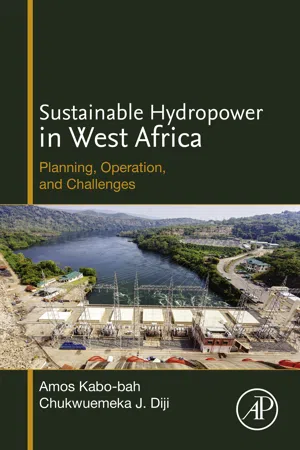
Sustainable Hydropower in West Africa
Planning, Operation, and Challenges
- 232 pages
- English
- ePUB (mobile friendly)
- Available on iOS & Android
Sustainable Hydropower in West Africa
Planning, Operation, and Challenges
About This Book
Sustainable Hydropower in West Africa: Planning, Operation, and Challenges provides a comprehensive overview of the planning, deployment and management of hydropower in West Africa and similar regions. The authors use a practical approach to analyze available technology, modeling methodologies and sustainability aspects, such as the dependence between climate and hydropower, and socio-economic and environmental impacts. They discuss the need for innovative solutions and how to close research gaps in the field for this region. Although more than 50% of West Africa's hydropower potential is still untapped, re-engineering and maintenance of existing hydropower plants is a key issue and is discussed.
Issues of productivity and optimization are also covered, as well as the introduction of new technology and integration of hydropower into existing energy systems—renewable energy systems, in particular. Policy and regulation are also examined, considering competing needs when managing water resources. The final chapter offers a summary of activities, strategies, policies and technology for easy reference and practical use.
Due to its wide coverage and real life examples, this is a useful reference for engineering professionals in the field of hydropower, working in West Africa and regions with similar conditions. This book helps engineers make technology and location decisions for planning, deploying and operating hydropower plants. The book's accessible language and international authorship also allows for easy use by energy researchers, analysts and policy makers who need information for the analysis, modeling, financing, implementation and regulation of hydropower in West Africa and related regions.
- Presents the most current issues related to hydropower deployment and management in West Africa and regions with similar conditions
- Discusses key challenges, focusing on practical aspects and methodologies
- Explores the technological, sustainability and economic aspects to be considered when deploying, operating and maintaining hydropower plants in West Africa and similar regions
Frequently asked questions
Information
Climate Change and Hydrovision
† University of Energy and Natural Resources, Sunyani, Ghana
Abstract
Keywords
1 Introduction
Table of contents
- Cover image
- Title page
- Table of Contents
- Copyright
- Contributors
- Foreword
- Introduction
- Chapter 1: Climate Change and Hydrovision
- Chapter 2: Promoting Research in Sustainable Energy in Africa—The CIRCLE Model
- Chapter 3: Hydropower and the Era of Climate Change and Carbon Financing: The Case From Sub-Saharan Africa
- Chapter 4: Hydropower Development—Review of the Successes and Failures in the World
- Chapter 5: Climate Change and Societal Change—Impact on Hydropower Energy Generation
- Chapter 6: Renewable Energy and Sustainable Development
- Chapter 7: The Potential and the Economics of Hydropower Investment in West Africa
- Chapter 8: Hydropower Generation and Its Related Impacts on Aquatic Life (Fisheries)
- Chapter 9: Socioeconomic Impacts of the Bui Hydropower Dam on the Livelihood of Women and Children
- Chapter 10: Peri-urban Households’ Constraints to Water Security and Changing Economic Needs Under Climate Variability in Ghana
- Chapter 11: Legislation on Hydropower Use and Development
- Chapter 12: Re-engineering Hydropower Plant for Improved Performance
- Chapter 13: Hydropower Generation in West Africa—The Working Solution Manual
- Index